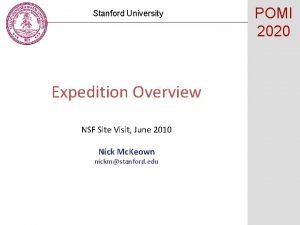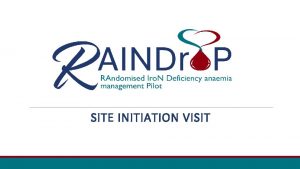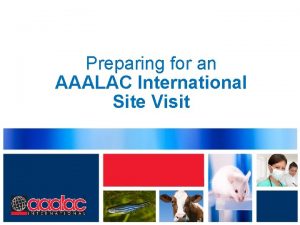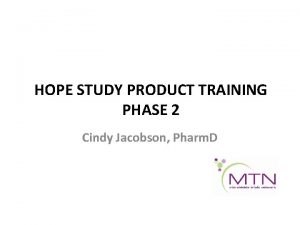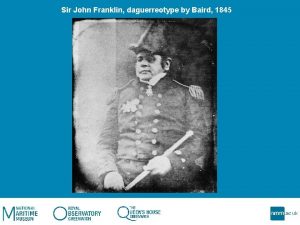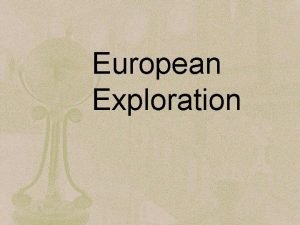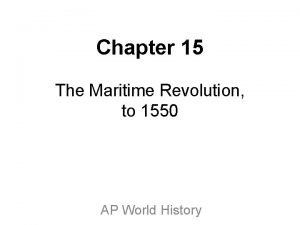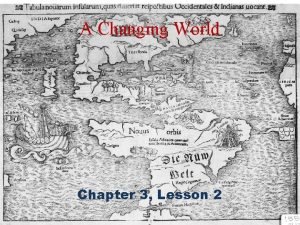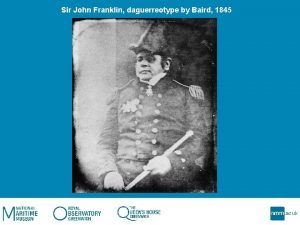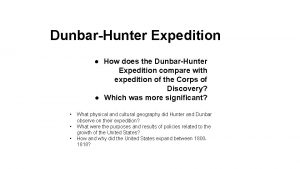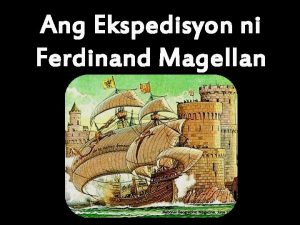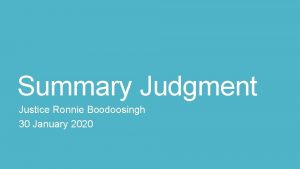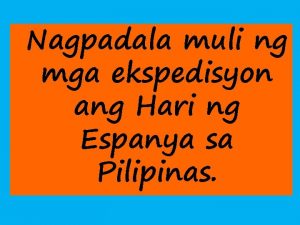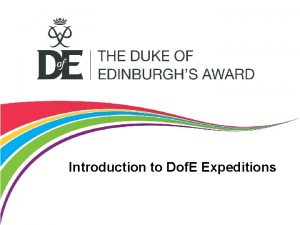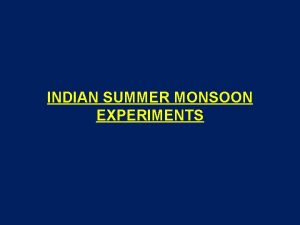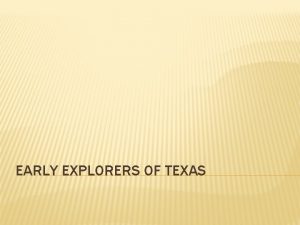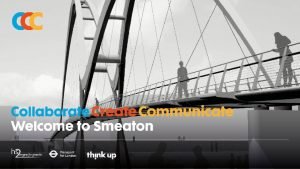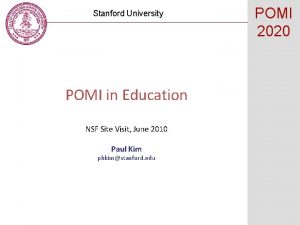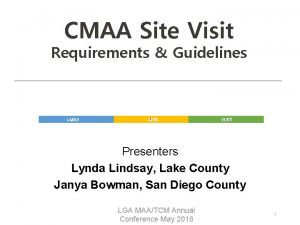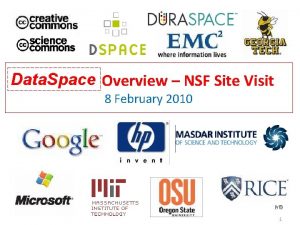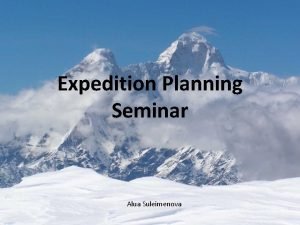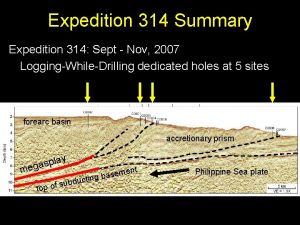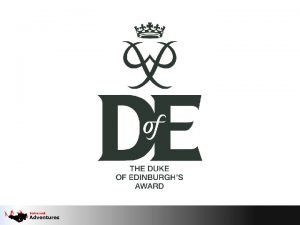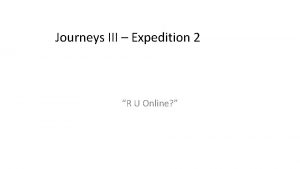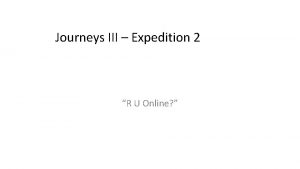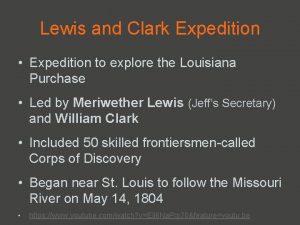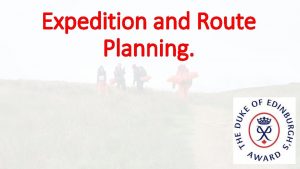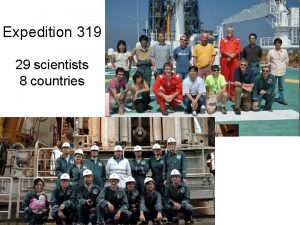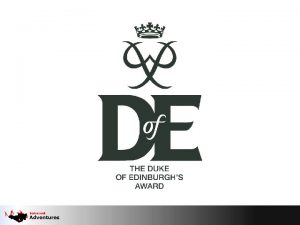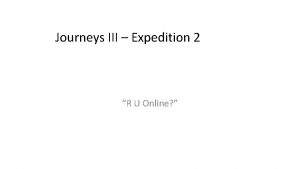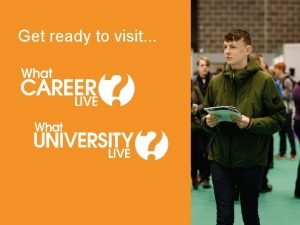Stanford University Expedition Overview NSF Site Visit June























- Slides: 23

Stanford University Expedition Overview NSF Site Visit, June 2010 Nick Mc. Keown nickm@stanford. edu POMI 2020

Outline • • How our Expedition started The rise of the handheld computer Handhelds need good infrastructure Barriers to innovation The POMI Research Agenda Our team Research Highlights and Self Assessment Today’s agenda 2

Clean Slate Program formed Guru joins as Exec Dir Seed 2006 POMI Expedition Launch NSF Reverse Site-Visit Preparation You are here POMI Program 2007 2008 i. Phone Android SDK + Google $4. 6 B “open” spectrum bid 2009 2010 3

The rise of the handheld computer Some trends were obvious: – For billions of people, a handheld is their first and only computer; their first access to the Internet – New applications, new populations of users – Data and computation will move to the cloud – We will increasingly… • • Depend on our handheld devices Care what happens if we lose them Be concerned with our privacy Want to preserve and control battery life 4

Handhelds need good Infrastructure It suggested a research agenda Handhelds: 1. Give users more control of energy usage 2. Improve the security of the OS and applications 3. Make it easier to develop applications for new populations Infrastructure: 1. Improve our connectivity to the cloud 2. Improve the privacy of our data in the cloud 3. Allow us to offload computation to the cloud 5

A second thread: Barriers to Innovation The infrastructure – Big brother portals grabbing more of our data – …and locking us in to few applications – Network and cellular industries closed, with big barriers to entry g slow innovation – Wireless capacity abundant, but off-limits – On its own, industry won’t address our concerns – We should try 6

Four barriers to innovation 1. Big brother portals increasingly own our data 2. …and limit the applications we can run 3. There is abundant wireless capacity around us, but it is closed and unavailable 4. The network infrastructure is closed and will remain ossified 7

Putting it all together Video streaming Radio technology HCI Distributed Systems Networking Tech for Education Economics Operating Systems Low-power computing 8

POMI Research Agenda Infrastructure Applications Handheld Secure mobile browser Cinder: Energy aware, secure OS HW Platform Data & Computing Substrate Pr. Pl, Junction and Concierge Network Substrate Software Defined Network & Open. Flow Radio technology Economics UI

POMI Research Agenda Infrastructure Applications Handheld Secure mobile browser Cinder: Energy aware, secure OS HW Platform Data & Computing Substrate Pr. Pl, Junction and Concierge Network Substrate Software Defined Network & Open. Flow Radio technology Economics UI

What we found ourselves talking a lot about… Openness Choice of Choice & Competition Innovation – Data-location – Wireless network – Spectrum Lack of innovation – Network 11

Approach & Strategy • Start with the POMI Research Agenda • Understand do research on technical challenges • Understand identify strategies to change the practice – This is unusual, but most fitting for an Expedition • Where relevant: – Build open platforms for innovation – Make them available to others 12

POMI Team Education Paul Kim Roy Pea Applications Leo Guibas Bernd Girod Jeff Heer HCI Scott Klemmer Dan Boneh Security John Mitchell John Ousterhout Distributed Systems Monica Lam David Mazières OS Phil Levis Economics Mendel Rosenblum Ramesh Johari Guru Parulkar Networking Nick Mc. Keown Fouad Tobagi Radio Sachin Katti + 67 graduate students Arogyaswami Paulraj Departments of EE, CS, MS&E and School of Education

Research Highlights Mobile Handheld – Created Cinder: An open source energy-aware secure OS micro-kernel – Addressed security problems with mobile browsers and applications Mobile Applications – Created visual interactive applications exploiting new devices, 3 G/4 G networks, and POMI platforms – Examples include image-web, visual search, mobile augmented reality Radio – Progress towards radios beyond 4 G – Interference mitigation, cooperating network coding, MIMO channel modeling Network Economics – New insight into economic implications of network horizontalization 14

Research Highlights Data & computing substrate for mobile social computing – Architecture: three key paradigms of social interactions enabled by safe-haven of data and interactions – Experimental platforms and applications for privacy-protected mobile social computing – Building a community around an open mobile social API Networking substrate: SDN/Open. Flow Wireless – Designed and prototyped SDN platform – Validated with multiple research experiments – Extended to radio-independent mobile wireless networks – Early demonstrations of giving users choice of network(s) – New research agenda for virtualizing radio network 15

Education and Broadening Participation • Bringing POMI 2020 research to 10+ classes • Attracting great students to Stanford because of POMI • Attracting underrepresented groups to the program • Taking mobile technologies to underrepresented groups – Pocket. School, PISA, PISILAN, design-based learning – Helping students with learning – Prototyped and experimenting with voice-based social media for rural developing regions – Learning from the experience 16

POMI Expedition Management Executive Director Guru Parulkar Faculty Director Nick Mc. Keown Faculty Steering Group – Dan Boneh – Monica Lam – A. Paulraj – Mendel Rosenblum External Advisory Board Siavash Alamouti Vodafone Bob Iannucci ex Nokia Larry Peterson Princeton Bill Raduchel ex AOL Rick Rashid Microsoft Andy Rubin Android/Google Stefan Savage UCSD Scott Shenker Berkeley Steve Trilling Symantec Hal Varian Google/Berkeley

How we organize • Weekly POMI Meetings: Updates on research; helps to start collaborations • POMI Retreats: 2 per year • POMI Workshops: Annual event, 150 people • POMI Advisory Group: like an industry TAB • POMI Steering Group: meet regularly to decide focus and funding 18

Agenda for Site Visit Focus on the Big Picture, not individual research talks – Data & Computing Substrate – Networking Substrate – Cinder Operating System – Security Demos/posters give a sense of individual research projects Self-Assessment 19

Self Assessment + Assembled and engaged a world-class team + Created a research agenda with opportunities for research impact + … and to change the practice + Architected and built first demonstration vehicles (mobile social, network, handheld OS, pocket. School, augmented reality, …) +/- Getting them into the hands of others 20

Self Assessment (2) - Steering several industries: We may have taken on too much - Too much system building? - Ramp up has been variable + Benefitted from SOE broadening programs - Need to work closely with SOE programs 21

We have lots of work ahead 1. 2. 3. 4. 5. Learn by putting applications into more hands Learn by putting platforms into more hands Creation and dissemination of POMI Kits Hosting and training POMI users Influencing policy makers 22

Agenda 08. 00 - 08. 30 Overview Nick Mc. Keown 08. 30 - 09. 30 Barriers 1 & 2 Data and Computing Substrate. Monica Lam 09. 30 - 10. 30 Barriers 3 & 4 Network Substrate. Nick Mc. Keown 10. 30 - 11. 00 BREAK AND EXEC SESSION FOR VISIT TEAM 11. 00 - 11. 45 Demonstrations by students - Packard Atrium 11. 45 - 12. 30 Mobile Handheld Software a. Cinder: Energy Aware Secure OS for Handsets Phil Levis b. Security and Privacy in Mobile Browsers Dan Boneh 12. 45 - 01. 30 Lunch with students 01. 30 - 02. 00 EXEC SESSION FOR VISIT TEAM 02. 00 - 02. 20 Broadening Participation Mendel Rosenblum 02. 20 - 02. 30 Use of POMI 2020 for under-represented communities Paul Kim 02. 30 - 02. 40 Voice-based social media for rural regions Scott Klemmer 02. 40 - 03. 00 Knowledge Transfer and Societal Impact Guru Parulkar 23
 Nsf site visit
Nsf site visit Hot site cold site warm site disaster recovery
Hot site cold site warm site disaster recovery Site initiation visit powerpoint presentation
Site initiation visit powerpoint presentation Sop sign off sheet
Sop sign off sheet Aaalac site visit
Aaalac site visit Site visit log
Site visit log Franklin expedition daguerreotypes
Franklin expedition daguerreotypes Loaisa expedition
Loaisa expedition Lewis and clark expedition summary
Lewis and clark expedition summary Geoearth game
Geoearth game Balboa expedition
Balboa expedition Loaisa expedition
Loaisa expedition Balboa expedition
Balboa expedition Franklin expedition daguerreotypes
Franklin expedition daguerreotypes Dunbar-hunter expedition map
Dunbar-hunter expedition map Ang ekspedisyon ni ferdinand magellan
Ang ekspedisyon ni ferdinand magellan Expedition into saicor
Expedition into saicor Ekspedisyon noong 1525
Ekspedisyon noong 1525 Qualifying expedition aim
Qualifying expedition aim Monsoon expedition monex
Monsoon expedition monex Why did coronado find his expedition disappointing?
Why did coronado find his expedition disappointing? Expedition engineering
Expedition engineering Expedition food ideas
Expedition food ideas Antarctic expedition
Antarctic expedition
